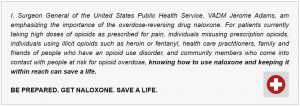Which Superhero Wears the Cape? Researchers Decide Who Should Carry Naloxone
Governments are spending millions to get Narcan Nasal Spray (aka Naloxone) in the hands of those who may be able to save lives in an opioid-related emergency. Who should be sponsored to carry Naloxone? This question is being raised by researchers and activist, as government and public health experts debate what might be the most practical and cost-effective solution(s) to reduce deaths due to opioid overdose.
According to Dr. Jerome Adams, the Surgeon General of the United States, he simply responded: “Everyone.” In April 2018, Dr. Adams issued the office’s first emergency advisory warning since 2005. This was a big deal. He essentially called on everyone, from people who use drugs, to community members that come in their path to carry Narcan. You can view the Surgeon General’s advisory here.

Naloxone has been credited with reversing thousands of opioid overdoses worldwide. A publication by the CDC reveals ~26,500 reversals by laypersons in the United States. The medication currently requires a prescription in the United States, a long-standing decision that has lead to media outlets and research study reports which claim the medication is difficult to obtain for the people and organizations that need it most. These findings have resulted in a public health dilemma, especially in amid an opioid crisis that leads to about 47,000 deaths annually.
Researchers* reviewed several distribution methods for increasing access to Naloxone. Some of their investigative methods included:
- distribution to non-medical first responders (i.e., law enforcement, fire departments),
- co-prescribing with prescription opioids (for chronic pain treatment)
- community-based and pharmacy naloxone distribution
The report intended to better understand which of these methods was the most cost-efficient, and likely to reverse an opioid overdose. The review revealed that community-based programs are likely the most effective and cost-efficient methods for distributing Naloxone to successfully reverse overdoses. These programs increase access to laypeople (who are usually loved ones of people who use drugs) via community programs and pharmacies.
Although the researchers recommend further research is necessary, it’s clear that people in the community can have a big impact on reversing overdoses and saving lives. As the city, state, and federal governments pour millions to get Naloxone into the hands of first responders, maybe they should also consider providing Naloxone to the people who directly support people who use drugs.
This blog is provided to promote information only. The content and any covered materials are not a substitute for medical advice or treatment. Always contact a licensed healthcare professional for any medical related concerns. The views expressed are not sponsored by and do not represent the opinions of Script Health.
*The University of Pennsylvania Leonard Davis Institute of Health Economics and the Center for Health Economics of Treatment Interventions for Substance Use Disorder

1 Comment. Leave new
Great content! Super high-quality! Keep it up! 🙂